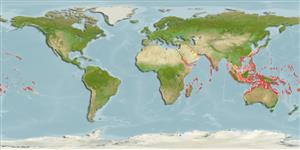Teleostei (teleosts) >
Centrarchiformes (Basses) >
Cirrhitidae (Hawkfishes)
Etymology: Paracirrhites: Greek, para = the side of + Latin, cirrus = curl (Ref. 45335).
Eponymy: Johann Reinhold Forster (1729–1798) was a German clergyman in Danzig (now Gdansk, Poland). [...] (Ref. 128868), visit book page.
More on author: Schneider.
Environment: milieu / climate zone / depth range / distribution range
Ecology
Marine; reef-associated; depth range 0 - 35 m (Ref. 37816), usually 5 - 35 m (Ref. 27115). Tropical; 24°C - 27°C (Ref. 27115); 35°N - 36°S, 28°E - 124°W
Indo-Pacific: Red Sea and East Africa (Ref. 5469) to the Hawaiian, Line, Marquesan and Ducie islands, north to southern Japan, south to New Caledonia and the Austral Islands. Unknown from the Persian and Oman gulfs (Ref. 11441).
Size / Weight / Age
Maturity: Lm ? range ? - ? cm
Max length : 22.0 cm TL male/unsexed; (Ref. 30573); common length : 18.0 cm TL male/unsexed; (Ref. 30573)
Dorsal spines (total): 10; Dorsal soft rays (total): 11; Anal spines: 3; Anal soft rays: 6. Body yellowish with broad blackish stripe on upper side; head and anterior part of body with small dark reddish spots (Ref. 5469).Color changes with growth as well as varies among adults (Ref. 37816). In Oceania, juveniles are a golden green dorsally and white ventrally; in continental areas juveniles may be red dorsally (Ref. 37816). The maroon and yellow phase was originally described as a distinct species, P. typee (Ref. 37816).
Inhabits clear lagoon or seaward reefs to at least 33 m depth (Ref. 9710), but may venture very deep. Occurs openly on coral and soft-bottom habitats, occasionally in pairs (Ref. 48636). Benthic (Ref. 58302). Tends to perch on outermost branches of Stylophora, Pocillopora, and Acropora corals (Ref. 9710). Feeds mainly on small fishes and crustaceans, sometimes on shrimps and is territorial and haremic (Ref. 37816). Solitary on corals (Ref 90102). Marketed mostly fresh. Minimum depth reported taken from Ref. 128797.
Life cycle and mating behavior
Maturity | Reproduction | Spawning | Eggs | Fecundity | Larvae
Distinct pairing. Spawning ascents into the water column occurred over a distance of 1.0 to 2.5 m (Ref. 26305).
Randall, J.E., G.R. Allen and R.C. Steene, 1990. Fishes of the Great Barrier Reef and Coral Sea. University of Hawaii Press, Honolulu, Hawaii. 506 p. (Ref. 2334)
IUCN Red List Status (Ref. 130435: Version 2024-1)
Threat to humans
Harmless
Human uses
Fisheries: minor commercial; aquarium: commercial
Tools
Special reports
Download XML
Internet sources
Estimates based on models
Preferred temperature (Ref.
123201): 24.5 - 28.8, mean 27.5 °C (based on 856 cells).
Phylogenetic diversity index (Ref.
82804): PD
50 = 0.5156 [Uniqueness, from 0.5 = low to 2.0 = high].
Bayesian length-weight: a=0.00871 (0.00433 - 0.01753), b=3.09 (2.91 - 3.27), in cm total length, based on LWR estimates for this species & (Sub)family-body (Ref.
93245).
Trophic level (Ref.
69278): 4.3 ±0.76 se; based on food items.
Fishing Vulnerability (Ref.
59153): Low vulnerability (12 of 100).
Nutrients (Ref.
124155): Calcium = 67.1 [43.2, 111.7] mg/100g; Iron = 0.753 [0.477, 1.150] mg/100g; Protein = 19.2 [18.1, 20.1] %; Omega3 = 0.155 [0.098, 0.241] g/100g; Selenium = 27.3 [15.6, 50.1] μg/100g; VitaminA = 168 [64, 436] μg/100g; Zinc = 1.25 [0.88, 1.71] mg/100g (wet weight);
